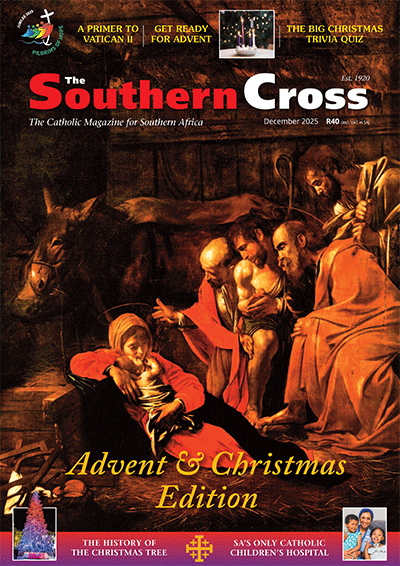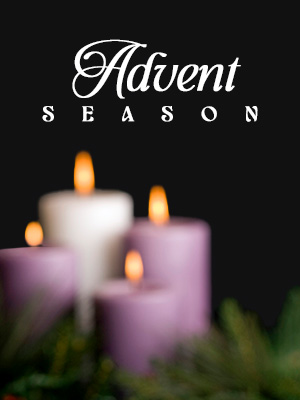Bishop Sylvester David OMI: The Hurley I Knew

Bishop Denis Hurley’s first official episcopal portrait in 1947 on the left. Inset: Bishop Sylvester David OMI
Today 107 years ago on 9 November 1915 Denis Hurley OMI was born. Bishop Sylvester David OMI remembers Durban’s archbishop of 45 years.
It is a privilege to pen a few lines about the late Archbishop Denis Hurley OMI of Durban, who was ordained a bishop 75 years ago on March 19. I was born and raised in the archdiocese of Durban during the 45-year-long episcopal ministry of Archbishop Hurley.
There was a strong Oblate presence among the clergy of Durban in those days — not encountering an Oblate of Mary Immaculate, whose numbers included Hurley, was more the exception than the rule. My parents, uncles and aunts, siblings, cousins and I all received the sacraments during the time Hurley had oversight of Durban. He confirmed me in the 1970s — and in 1991, he ordained me, by then also an Oblate, to the priesthood.
There used to be a blurred distinction between the office of the Oblate provincial and that of the archbishop. For example, shortly after my ordination to the diaconate at the hands of Bishop Daniel Verstraete OMI, then of Klerksdorp, Hurley visited the scholasticate at Cedara and asked what my plans were. I told him that it had been discussed by the congregation that I should study family therapy and, in fact, had already completed postgraduate studies at UNISA. He thought it was a bad idea and that I ought to get into parish ministry as soon as possible. I will never forget the discussion as he concluded it by physically showing me how a famous South African fast-bowler’s action was correct and not out of sync as was speculated by some cricket commentators!
Growing up in an Oblate environment which was frequented by Fr Charles Langlois OMI, Hurley’s vicar-general at the time, many of us young people in the parish were exposed to the Church’s Social Teachings as the archbishop arranged lectures, discussions and talks. These discussions made sense and stimulated us to start asking questions. We noticed in Hurley an undying commitment to justice, and there were times when he took to the streets in protest. Indeed, his episcopal motto was “Ubi Spiritus, ibi libertas” — “Where the Spirit is, there is freedom”.
Hurley’s name became synonymous with a search for justice. I clearly remember the first time I voted as a South African citizen in 1994. I was 41 years old and the immediate feeling was one of relief. The first thing I did when I returned to the community was to write to Archbishop Hurley to thank him for all he had done to help usher in the new dispensation for our country.
Hurley had an intellectual curiosity that spilled over from theology and philosophy into such fields as quantum physics and the essential connectedness between mind and nature. He ventured into the thinking of Pierre Teilhard de Chardin SJ and, at the drop of a hat, could give a discourse on the stages of development ranging from “bio-genesis” all the way through to “noo-genesis”.
Love of books
His love for the world of books was formally recognised in a meaningful way when the library at St Joseph’s Theological Institute at Cedara was named after him. He unveiled a bust of himself on that occasion and spoke of his favourite authors, listing such names as Yves Congar and Henri de Lubac, among many others. He described the 1950s as a period of great literary activity during which books poured out of the world’s printing presses in order to enlighten the mind of the Church in preparation for the Second Vatican Council — in which he would play a leading role.

(Left) The Hurley family with oldest children, Denis and Eileen. (Centre) Bishop Hurley with the telegram informing him of his elevation to archbishop in 1951, with US Oblate superior Fr Charles Barry and Fr Joseph Pucci OMI, a former classmate in Rome. (Right) Archbishop Denis Hurley’s tomb in Durban’s Emmanuel cathedral.
Hurley was associated with the Community of Sant’Egidio, a worldwide lay movement based in Rome, and he was frequently invited to the Eternal City to attended one event or another arranged by the community. During my three-year sojourn in Rome, he visited the Oblate General House about five times. He readily joined in the community activities and often “stole the limelight” with his spontaneous and effervescent wit and humour.
Two of the best lectures I had in ecclesiology took place on St Peter’s Square — both given by Hurley. His insights were critical and his mind always razor-sharp.
He very fondly recalled an unusually loud applause after concelebrating bishops entered the square after a certain Mass in St Peter’s basilica. Thinking this might have been a special group on pilgrimage, he soon found out the real reason for all the excitement. It was not the impressive procession of bishops but a little woman in a blue and white sari who got the crowd going. Mother Teresa had just entered the square. Though not given to being self-effacing, Hurley did possess the healthy attitude of being able to laugh at himself.
A decisive leader
Hurley’s leadership style was decisive. One always knew where one stood with him. If he was convinced of an idea, he committed to it. This does not in any way mean that he clung to false absolutes — on the contrary, he showed a great openness to change even prior to his priestly ordination. One is often reticent to speak of the need for growth in one’s heroes, but perhaps true greatness lies in the hero’s ability to overcome incorrect perceptions and to make the necessary adjustments. Hurley constantly preached conversion — a New Testament word which means to go beyond one’s ordinary way of thinking. It is an invitation to see the world through new lenses and to broaden one’s vision.
Hurley was such a man. In the early part of his biography of Denis Hurley, Guardian of the Light, author Paddy Kearney shows that Hurley embraced the social perspectives of his time — referring in less than positive terms to his fellow South Africans who worked on the ship Carnarvon Castle which took him to distant shores, and symbolically to new horizons. Kearney reports that whereas Hurley left South Africa in 1932 very much “a white boy”, he returned in 1940 transformed by the Catholic Social Teachings he had learnt in Rome. The rest is history.
Only love matters
Hurley spent the last days of his life in the Oblate Community in Sabon House, Durban. There, like all the other residents, he took turns to preside at Mass and at the Liturgy of the Hours. He enjoyed a very good sense of humour and readily engaged in community conversations.
I remember when shortly before his death on February 13, 2004, he joined the wider district community-gathering a bit late as he had just returned from pastoral work. He was enthusiastic about the reading from Zephaniah about God who will dance over his beloved children. He summed it up by giving what is now his famous tribute to love: “More and more I realise that love is the only thing that matters. Love makes the difference.”
In paying tribute to the virtue of love he quoted St Paul that three things remain — faith, hope and love (1 Corinthians 13:13) — and urged us never to forget that of these three qualities, love is the most important.
Bishop Sylvester David OMI is the auxiliary bishop of Cape Town.
The life of Hurley: A Timeline
1915: Born on November 9 in Cape Town, the second of four children of Irish-born lighthouse-keeper Denis Sr and Theresa Hurley.
1931: Matriculates at St Charles’ College in Pietermaritzburg.
1932: Joins the Oblates of Mary Immaculate novitiate in Ireland.
1933: Sent to Rome to study for the priesthood at the Angelicum University.
1939: Ordained to the priesthood on July 9 in Rome.
1940-43: Curate at Emmanuel cathedral in Durban.
1944: Appointed superior of St Joseph’s Oblate Scholasticate, near Pietermaritzburg.
1946: Named vicar-apostolic of Natal with the rank of bishop.
1947: Episcopal ordination on March 19.
1951: Elevated to rank of archbishop with the establishment of the archdiocese of Durban.
1952-61: First President of the Southern African Catholic Bishops’ Conference (SACBC).
1961: Appointed to the Central Preparatory Commission for the Second Vatican Council.
1962-65: Attends Vatican II, giving ten speeches and making four written submissions; elected member of the Commission for Priestly Formation and Christian Education. Writes anonymously from the council for The Southern Cross.
1965-66: President of the SA Institute of Race Relations.
1968: Convenes first diocesan synod in South Africa’s Catholic Church in Durban.
1969-74: Member of Congregation for Divine Worship.
1972-86: Apostolic administrator of the diocese of Umzimkulu.
1974: Attends his first Vatican Synod of Bishops (and again in 1977, 1980, 1985).
1975: Elected chairman of International Commission on English in the Liturgy (ICEL).
1976: Founds the Diakonia Council of Churches in Natal.
1981-87: Second stint as president of the SACBC.
1984: Charged in the Pretoria High Court for making “false statements” concerning Koevoet atrocities in Namibia (his statements turn out to be correct, and the charges are dropped in February 1985).
1985: Brings Supreme Court application which leads to the first court-ordered release of political detainees.
1992: Retires as archbishop of Durban, and is appointed parish priest of Emmanuel cathedral until his retirement in 2002.
1993-98: Chancellor of the University of Natal.
2004: Dies of cardiac arrest on February 13, and is buried in the Lady chapel of Emmanuel cathedral after a Requiem Mass at Absa Stadium, Durban, on February 28.
2015: The Denis Hurley Centre, located next to Emmanuel cathedral, is formally launched on Archbishop Hurley’s centenary.
Published in the March 2022 issue of The Southern Cross magazine
- Fathers James Rice and Paul Moore Ordained Priests for the Archdiocese of Cape Town - December 17, 2025
- 460 Eastern Cape Children Receive Essential Care and Meals in Week-Long Holiday Camp - December 16, 2025
- Fr Peter-John Pearson: Where SA and Vatican Stand Together - December 15, 2025





